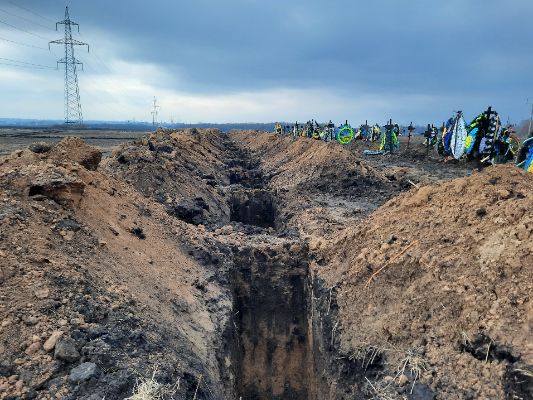
Glen Johnson Reports From Ukraine. 14.07.2023
ZAPORIZHZHIA, Ukraine – At the start of June, Ukraine’s defense ministry released a PR video of soldiers holding single fingers to their lips and vowing silence – “Shhh” – around their up-coming offensive operations.
“Plans love silence,” the text at the end of the 34-second video read. “There will be no announcement of the start.”
The Ukrainian offensive had begun. And it was more or less exactly where everyone expected it: on the Zaporizhzhia front.
Within days, German tanks and significant numbers of US-supplied armoured fighting vehicles were burning on the prairielands of east Ukraine.
It was not the start that Ukraine, its backers in the West, or NAFO trolls were hoping for.
On June 4, Ukraine launched an initial push around Velyka Novosilka, targeting the least fortified area of a formidable southern frontline that stretches the length of Zaporizhzhia Oblast.
Multiple battalions from two mechanized brigades rolled onto the grasslands along the line of contact, a three-pronged push aiming to identify seamlines and weak spots in the hamlets and villages of a 17-kilometer-long screening zone before Russia’s main, or first, defensive position.
It was a complete rout.

Footage from multiple drones broadcast on Russian Telegram channels showed dozens of damaged and destroyed tanks and US-supplied MaxxPro “mine resistant” vehicles, plumes of smoke rising.
Advancing in armoured columns, the Ukrainians became caught in minefields and were pummeled by artillery and kamikaze drones. Russian Ka-52 “Alligator” helicopters roamed the skies, seemingly unchallenged by Kyiv’s air-defense systems, which are running on fumes.
Highlighting the chaotic violence, one video showed Ukrainian vehicles driving in disoriented circles, before being picked off. Casualty figures are a closely guarded secret here. Regardless, Ukraine’s losses were significant.
“Nobody was [providing artillery support] from our side. They just threw us here. I don’t know why,” said one soldier, standing before a cluster of downtrodden men in a video posted to Telegram. “We refuse to fight under the command of our battalion. Because they just sent us to our deaths.”
This first wave appeared comprised of recently trained conscripts and territorial defenders, sent into battle with minimal training: cannon fodder.
A similar Ukrainian push from Orikhiv in Zaporizhzhia’s west – this time using elite troops trained by the West – and ultimately geared towards reclaiming Tokmak and Melitopol, ran into similar problems, with the first confirmed kill of a German-made Leopard 2 tank. It would not be the last.
Two brigades, including the elite NATO-trained 47th mechanized brigade, were involved in the assault. The Ukrainian army formed nine new brigades comprising 2,000 men each, receiving crash courses, with the offensive in mind. The goal was to sever the land bridge between Russia and Crimea and ultimately reclaim territories occupied by Moscow since 2014.
And, hopefully, not trigger nuclear Armageddon in doing so.
Equipped with Leopard tanks, M-2 Bradley fighting vehicles and backed-up by artillery, the 47th brigade became trapped in minefields near Mala Tokmachka. It was savaged by Russian materiel, losing up to 10 percent of its equipment.
The Ukrainians had not even reached the first Russian line of defense, let alone breached it.
“The loss of equipment…is not an indicator of the future progress of Ukraine’s counteroffensive,” wrote the Washington-based Institute for the Study of War, a neoconservative thinktank on June 8, ignoring the scores of Ukrainian men who had just been incinerated. “It is important not to exaggerate the impact of initial losses of Western or any other equipment, particularly in penetration battles against prepared defensive positions.”
Put another way: “Shhh”.
Just over a month on, the situation had stablised somewhat for Kyiv, with a change-up in tactics and some gains, but at significant cost. A large, well-armed reserve force is also being held back, waiting to exploit any openings.
But it is unlikely to replicate its rapid Kharkiv sweep of last summer, where Kyiv had the element of surprise and was facing thinly dispersed, low-grade Russian troops.
The fortifications that the Russian Army built up in Zaporizhzhia this past winter are formidable: A 120-kilometer-wide death trap comprising anti-tank ditches, mine fields, dragon’s teeth, and layers of trenches – some beginning after an approximately 20 kilometer kill zone. Tokmak alone is ringed by defenses.
And the Ukrainians are facing a much different army to what they won a string of victories over last year.
The meat grinder has come to Zaporizhzhia.

THE FERRYMAN
For months, the Ukrainian offensive was ceaselessly described by Western media as a “much anticipated counter-offensive”. But who – outside of newsrooms, drooling NAFO Twitter accounts, and most of Poland – was really doing all that much “anticipating”? It felt like the media was, well, reporting on itself.
The constant pressure certainly irritated Kyiv, with presidential advisor Mykhailo Podolyak blowing a fuse on Twitter in late April, as the psychotic Wagner mercenary group ground its inexorable path through Bakhmut, incendiary munitions repeatedly drifting down from the night sky like deranged molten snow.
“When will the counter-offensive start? In which direction will it be? How many people and equipment will there be? What is the battle plan? Journalists ask the same questions of everyone who can be called an ‘official’. Fans sit in the stands and want to know if there is still time to go to the cafeteria for chicken wings,” wrote Podolyak. “The fans are dissatisfied: photos of destroyed landscapes and wounded people no longer tug at the heartstrings…Meanwhile, ordinary Ukrainians who left civilian life to defend their country are preparing to claim their home day after day, but they do not understand where the promised ammunition, aircraft and long-range missiles are…”
Podolyak was saying the quiet part out loud: Ukraine was in no position to launch its “much anticipated counter-offensive”. It needed more time.
Kyiv’s manpower problem became abundantly clear over the past winter, as videos began to proliferate of fighting age men being rounded up, hauled from homes and street corners.
Horror stories emerged: conscripts sent to plug the front after only a couple of days of basic training; in one case a severely disabled man was reportedly declared fit for service despite missing both his hands.
One Facebook group page, for people trying to find relatives missing in action, is a flood of desperate appeals. “Half a year without your voice, without your smile, half a year I haven’t seen your beautiful eyes or felt your dear and tender embrace,” one group member wrote recently. “I ask with all my heart…has anybody seen my husband? Please write to me, please.”
Russia’s initial “special military operation” did not go well, particularly the columned advance from Belarus, which aimed to pacify Kyiv while a new regime was put into place.
The Ukrainians’ flexible command structure coupled with the tactical use of natural resources – flooding areas north of Kyiv by blowing the dam on the Irpin River – neutered any chance the Kremlin had of achieving a swift victory.
Similarly, NATO had trained tens of thousands of Ukrainian troops since 2015, part of a push to achieve “military interoperability”. Moscow was confronted by a professional, committed army. And strong opposition from swathes of the public.
And it got bogged down, suffering significant losses of equipment and personnel outside Kyiv, while managing to commit massacres such as in Bucha.
So, its war-planners turned to doctrine: grinding artillery warfare, where Moscow far-outstripped Kyiv – and its Western backers – in materiel. And they exacted a horrific toll last summer and autumn, despite successful, but personnel-expensive, Ukrainian offensives in Kharkiv and Kherson.
Blue and yellow, red and back flags flutter at cemeteries throughout Ukraine. At one cemetery in the sprawling city of Dnipro, rows of empty graves have already been dug, black soil mounded high to the side. Rudimentary wooden crosses mark the resting places of the unidentified dead.
“We are losing our nation’s biggest assets: programmers, businessmen, writers, artists, teachers: the intellectual gene pool, which is dying,” said Mariya (40), who runs a volunteer initiative, while walking in the eastern city of Kharkiv’s Shevchenko Garden as the Wagner group closed in on the final Ukrainian strongholds in Bakhmut mid-May. “That scares me much more than rockets.”
The Bakhmut meat grinder saw cemeteries here swell over the winter and spring. For a city that was often described as of only “limited strategic value”, Ukrainian President Volodymyr Zelensky was committed to holding it.
“We understand that after Bakhmut they could go further. They could go to Kramatorsk, they could go to Sloviansk, it would be open road for the Russians after Bakhmut to other towns in Ukraine, in the Donetsk direction,” said Zelensky in a March interview with CNN. “That’s why our guys are standing there.”
The maniac, Yevgeny Prigozhin, showed up with his army of Wagner psychos – a red flag to the media bull – and ensured that Bakhmut would become the site of the biggest slaughter on European soil since World War II.
It was widely rumoured that the more sensible head of the Ukrainian Armed Forces, Valerii Zaluzhny, was opposed to holding Bakhmut at all costs, instead falling back and bleeding advancing mercenary troops. But he was over-ruled by Zelensky and military intelligence. It may well be the case.
In the lead-up to the fall of Bakhmut, an uncomfortable contradiction reigned on the streets of Kramatorsk, some 30 kilometers from the Bakhmut death-pit.
“I love Russia. I am Russian. I speak Russian. My family speaks Russian. My relatives are in Russia,” one resident said, stood aside a building that had been hit by a Russian missile the previous night. “But now, I don’t want Russia to come here, because I don’t want [Kramatorsk] to become like Bakhmut.”
Regardless, this war’s death toll has been withheld from the public, in part because no one actually knows what it is. Uncomfortable as it may be to acknowledge, Ukraine has likely lost far more men than Russia and mind-boggling amounts of weaponry: a function of attritional warfare.
With the new elite units for the offensive given crash courses by NATO – and a patchwork of weaponry – skill sets have also deteriorated. That is not to say Ukraine cannot achieve its “victory”, rather that it will be extremely difficult and very bloody.
And the more successful Ukraine’s offensive becomes, the greater the likelihood of escalation by Moscow: The Kremlin considers Crimea, its Black Sea Fleet’s historic base, a core security concern, fundamental to Russian naval power projection.
The Ferryman is going to have a busy summer.
Little wonder Podolyak blew a fuse.
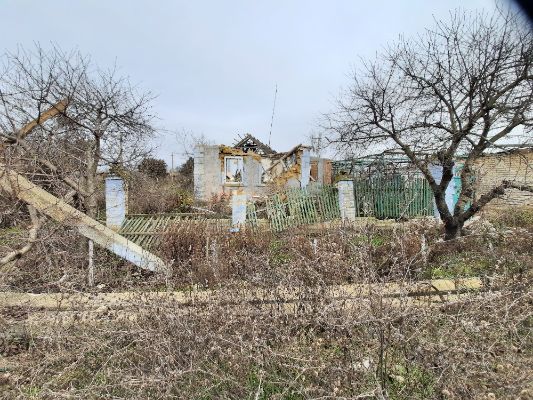
WHITE REX
In the weeks leading up to the offensive, Kyiv seemingly stepped-up attacks inside Russia, while maintaining plausible deniability, as head of military intelligence, Kyrylo Budanov, had telegraphed in an interview with the ABC’s Britt Clennett in January.
“Do you think there’ll be more, inside Russia?”
“I think so.”
“Inside Russia? Deep inside Russia?”
“Deeper and deeper.”
Oh, gross.
This reached apex in the days following the fall of Bakhmut at the end of May, when a militia, the Russian Volunteer Corps (RDK), headed by notorious neo-Nazi Denis Kapustin, who founded the white supremacist clothing brand White Rex, launched a cross-border raid from Kharkiv into Russia’s Belgorod province, using some US-supplied military hardware.
Also spotted in footage of the raid was Alexey Levkin, the founder and frontman of the black metal band M8L8TH – or “Hitler’s Hammer” – formed in Russia in the 2000s, and which is based in Ukraine. The two 8’s in the band’s name refer to the eighth letter of the alphabet and are code for the Nazi rallying cry, “Heil Hitler”.
Both men had been active in the neo-fascist Azov Battalion. Levkin was a visible figure in the Maidan protests of 2013-2014, which brought together “pro-European” civic activists angered by persistent corruption and then-President Viktor Yanukovych accepting a Russian trade deal, and Ukraine’s far-right, particularly armed Pravi Sektor activists.
Regardless, if Ukraine’s military intelligence has been working with RDK – and transferring Western weapons and hardware, which are provided on the condition that they only are used inside Ukraine – as seems likely, it is monumentally stupid and does little more than add weight to Russian President Vladimir Putin’s absurd claims to be “de-Nazifying” Ukraine.
The far-right is very influential in Ukraine, particularly with regards to memory politics. The current is ideologically rooted in the Western Ukrainian form of nationalism that began to crystallize in the mid-1800s, soured during the inter-war period and was hardened by emergent fascism and German “Blut und Boden” ultra-nationalism. It was harboured by elements in the diaspora post-WW2 and reimported into Ukraine following the Soviet dissolution.
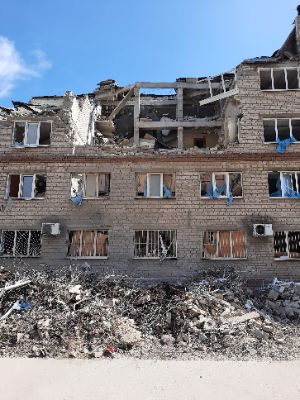
But Ukraine is also a diverse, tolerant country where a large majority do not hold such views. If anything, Putin’s invasion is generating and legitimising the very forces he claims to oppose, another massive own goal.
Then the Nova Kakhovka dam got blown, coinciding with the beginning of Ukraine’s “much anticipated counter-offensive”.
And everything began to escalate at breakneck speed – even absent particularly notable territorial gains.
The Wagner Group’s chief and former St Petersburg hotdog Kingpin, Prigozhin, would completely lose his mind, having previously appeared in videos stood afront piles of dead mercenaries while telegraphing strong Colonel Kurtz vibes.
He set off on an ill-advised raid inside Matushka Rossiya – an attempt to prevent his lucrative mercenary group from being folded into the Russian army – which could have ended so very much worse.
“I don’t think that Prigozhin and his gang of criminals will overthrow Putin’s regime and I don’t think it would be beneficial for Ukraine if Prigozhin takes over,” said a career Ukrainian diplomat at the time. “But as [Russia and Wagner] are fighting each other, we are happy with that. We have an expression for it: the toad fucked the viper.”
The horrifying prospect of nuclear catastrophe even reared its ugly head again.

ECOCIDE
The Ukraine war has featured spectacular acts of sabotage, with devastating environmental impacts. The bombing of the Nord Stream pipelines – regarding which Washington appears to have thrown Ukraine under the bus – was among the more horrifying, releasing some 100,000-plus tonnes of methane and stirring up vast amounts of heavily contaminated sediment.
Shocking scenes of water pouring through the breach at Kakhovka dam on June 6, wreaking havoc on downstream settlements, set off claims and counterclaims.
Obviously, the breach stalled any potential amphibious assault from the right bank of the Dnipro River in Kherson, which was widely expected to accompany the Ukrainians’ major offensive operations in Zaporizhzhia.
Yet, it also washed away Russian defenses on the left bank and, a month on, the upstream Kakhovka Reservoir, a formidable water barrier next to the Zaporizhzhia Nuclear Power Plant (ZNPP), had been reduced to scorched desert wasteland.
Kyiv had last year assailed Kakhovka Dam with Himars, attempting to create a limited breach that would have trapped some 30,000 Russian troops, impossible to resupply, on their right bank bridgehead as Ukraine upped the pressure in Kherson.
Whatever the case may be – smart money is on the Kremlin being behind this particular instance of ecocide – it is everyday people who are left to pick up the pieces.
“There is water everywhere,” wrote 21-year-old Angelina, a student in Kherson reached by Telegram at the time. “There is shelling, it is very dangerous. I want to leave.”
By the end of June, fears were once again spiking over the fate of the ZNPP.
Ukrainian military intelligence claimed that Russia, which has occupied the facility since early in the war, was preparing to blow it up. The Kremlin, for its part, said that the Ukrainians – whose “much anticipated counter-offensive” continued at snail pace, still not having reached the first line of defense – were preparing a false flag operation for July 5, ahead of NATO’s Vilnius summit, in which Ukraine would be front and center.
Either scenario could lead to rapid, unpredictable escalation.
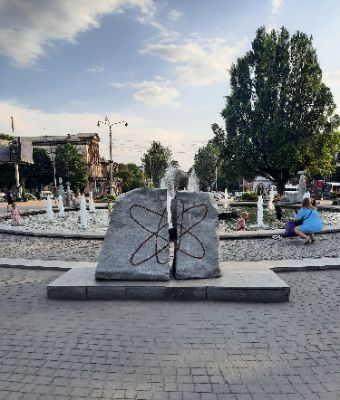
DOCTOR MANHATTAN
As the fated day rolled around, Zaporizhzhia trucked along.
Its restaurants buzzed, people lazed about in the searing summer heat beside the Dnipro River’s abnormally low waters downstream from Zaporizhzhia’s towering dam.
Authorities had advised residents, in the event of catastrophe, to stay indoors and close their windows. Wait for evacuation.
At the central Mayakovskoho square, teens emit clouds of vape. Children race about in battery powered toy cars, their parents trailing behind. Others splash about in the Fountain of Life, initially constructed in remembrance of the Chernobyl disaster.
One boulder, a feature of the fountain, is riven in two, inset with coloured stones depicting the atom.
A local contact, Helen, who works for the local government shares her thoughts as we walk around in the late evening sun.
“From the movies, you’d think that if it is the Last Day, you’ll do this and that, try to do things you’ve always wanted to do,” she says. “But no, it’s just like any other day.”

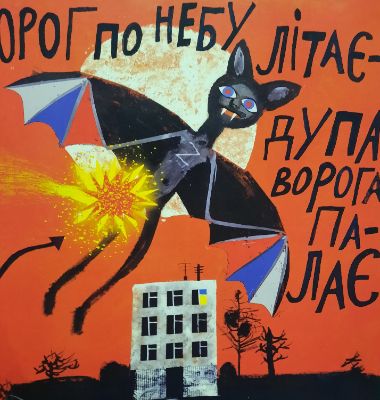
ENDS



